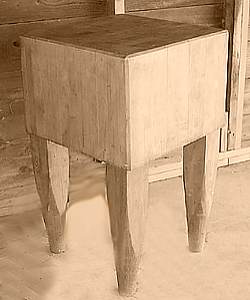Rules-Based Verses Face-to-Face Selling – Business of Doing Business – The Journal of Antiques and Collectibles – October 2004
By Ed Welch
All antiques and collectibles bought, sold, and traded in the antique marketplace can be pigeonholed in one of two categories, rules-based merchandise and face-to-face merchandise.
Rules-based merchandise includes all mass-produced collectibles and all signed art and other antiques that are easy to categorize. Depression Glass is a prime example of a rules-based collectible. So much is known about this item that knowledgeable buyers and sellers have access to all available information pertaining to the rareness, salability, and value. The seller does not have to sell this item. All that is necessary to make a sale is that the seller asks a price that is perceived to be the going price.
Depression Glass is an ideal collectible to sell in a group shop. Any sales clerk can handle the actual selling process, taking payment and writing a sales receipt. It is not necessary for the sales clerk to know anything about Depression Glass.
The basic rules for selling rules-based items are:
- The item must be properly identified.
- The item must be clean.
- The item must be in excellent condition.
- The item must be displayed in an attractive manner.
- The item must be priced at the perceived market value.
Violate any of these rules and the item will not sell.
Antique dealers who sell face-to-face items have an advantage in the antique marketplace. Generally, because of personal contact, they can receive more money for all items sold, including rules-based items. The major disadvantage in face-to-face selling is the cost to the seller in time and money. Face-to-face selling is more expensive than the methods used to sell rules-based items.
Face-to-face selling outlets include one’s own shop, antique shows, flea markets and group shops that require the dealer to be in his or her booth during normal business hours. Requiring the dealer to be in attendance is more common in Europe than in the U.S.
Rules-based selling outlets include group shops that make no demand on the seller’s time and auctions. Dealers who sell rules-based items and who choose to sell through the services of a group shop soon discover that certain items sell quickly if the asking price is kept to a given dollar amount. Unfortunately, thousands of other dealers have the same knowledge. The result is a high demand for such items. High demand inevitably leads to shrinking profit margins as dealers out pay each other for saleable merchandise.
The contact between the auctioneer and the bidder in an auction is not face-to-face selling. The auctioneer is acting as an agent for both buyer and seller, charging each a fee for services. The auctioneer adds an unneeded expensive layer between the seller and the buyer. Generally, auction house services add 35 percent to the cost of goods sold. In my opinion, this 35 percent is an unnecessary expense.
eBay has proven that auction selling can do without much of the services provided by an auction house. I can envision a selling service at which sellers place their own items on the block and buyers bid by pressing a button on a remote control similar to the ones used to change channels on the television set. Items for a given auction would be posted on a website and displayed at the selling site for potential buyers to view.
Advertising would become the responsibility of the seller. Each seller could do as much or as little advertising as he or she deemed necessary. The cost of operating such a selling service would be as much as 70 percent cheaper than the cost of operating an auction service. More about the workings of such a selling service in a future article.
The theory of rules-based businesses and jobs and face-to-face businesses and jobs is a well-known economic principle. Briefly, rules-based businesses and jobs are those in which work can be accomplished by following a set of rules step by step. Production line work is a good example of a rules-based job. If the production line worker follows instructions step-by-step, the task is easily completed. It is a simple matter for such a worker to place item “a” inside item “b” and fasten the two parts together using two number three screws.
The Chambermaid who cleans hotel rooms is a good example of a face-to-face job. One hotel guest may be neat and tidy, and not much work is required to ready the room for the next occupant. The guests in another room could be slobs who dropped pizza on the carpet and littered the room with beer cans and potato chips. It is impossible to write a set of rules to govern the work of a Chambermaid.
If I may be permitted to get a little off topic for an antiques related article, rules-based jobs and jobs performed by rote are the type of jobs outsourced to the foreign countries. It makes no different in the finished product if item “a” is placed inside item “b” and fasten together using two number three screws by an American worker making $15 per hour or a Chinese worker making 70 cents a day. Jobs performed by rote always go to the manufacturing source with the cheapest labor rates.
The janitor, the Chambermaid, and the waitresses will always have a job. Production and manufacturing jobs in the U.S. are a thing of the past. For more information on the American job market, I recommend the book, [amazon_link id=”0691119724″ target=”_blank” container=”” container_class=”” ]The New Division of labor: How Computers are Changing the Next Job Market[/amazon_link]. This is a Princeton University Press book. It is written by Frank Levy, Professor of Urban Economics at MIT and Richard J. Murnane, Professor of Education and Society at Harvard University.
Most mass-produce collectibles are rules-based items. If you sell these collectibles face-to-face from your own shop or at an antique show, you can charge slightly more than the perceived fair price. However, if you sell such items from a group shop, auction service including Internet auctions, your asking price must be the price that is perceived to be the fair price. At auction, if all the buyers are dealers, rules-based items will sell for less than half the perceived fair price.
Items that are considered to be face-to-face items tend to be rare, unusual, handmade, or very old. A country cupboard in original blue paint is a great example of a face-to-face item. This item is unique, it is handmade, it is one of a kind, and it is likely to be expensive. Such a cupboard, which is likely to cost $10,000 or more, would be very hard to sell from most group shops. The exception would be a high-end group shop that specializes in early American furniture. Dealers who specialize in high-end antiques and who want to receive the most money possible for each item must sell face-to-face.
In 1992 and 93, I was dealing in country furniture. I had bought and sold more than ten butcher blocks in the previous five years. I had a chance to buy five butcher blocks from one person. The size of the butcher blocks ranged from very small to extremely large. Two of the medium size blocks had never been used. They measured 30 inches tall and had a smooth top. The smallest block was well used and had a big worn spot in its top. The largest block, which must have weighed a thousand pounds, was slightly used and had a smooth top. Another large block was well used and had a major worn area in its top.
At the fall 1993 Brimfield show, I offered all five blocks for sale, all priced at $350.00 each. I sold the two medium blocks with the smooth tops the first day. I sold the large heavy block with the smooth top two days later. The two remaining blocks, one very small and one very large, had worn tops. They drew a lot of attention but no buyer.
After Brimfield, I bought a commercial hand-held planer and smoothed out the top of the remaining large block. It sold three days later at a weekend flea market. I then smoothed out the top of the small block. However, because the top was badly worn, the block was now too low to be useful and did not sell when I offered it at several shows. I added height by adding a shoefoot base to the legs. It sold at the next show.
From 1993 to 1996, I sold eighteen butcher blocks at the first show at which they were offered for sale. The selling price was $350.00. The tops were planed smooth. The blocks were scrubbed clean and refinished if needed. All the blocks measured between 28 and 32 inches tall. I had discovered the rules that govern the sale of butcher blocks.

Butcher block No. 19 remains in my warehouse, unsold, because I violated one of the rules of butcher block selling when I offered this item for sale seven years ago. Butcher blocks are a rules-based item. To successfully sell this item, a dealer must follow all the rules that govern the sale of butcher blocks.
When I bought block number 19, I decided to increase the price to $450.00. I offered this block for sale at more than ten shows. No one would pay the $450.00 asking price. I was offered $350.00 several times. The butcher block now sits in my warehouse. It has been in my warehouse for seven years.
The reason that I still own this block is that I violated one of the rules that govern the sale of butcher blocks. I violated the price rule. Had I violated one of the other rules, height, smooth top, cleanliness and finish, the no sale result would be the same.
Of course, I could lower the price to $350.00 and sell this butcher block at my next show. However, I sort of like looking at this item. It is a constant reminder that mass-produced collectibles are best sold using a rules-based formula. The task of the dealer is to find out what the rules are and then follow those rules.
Butcher blocks, priced at $350.00 that have a smooth top and proper height, are an ideal item to sell in group shops. If all the rules of butcher block selling are followed, no face-to-face contact is needed. The block will sell itself.
For years, I called the selling of mass-produced items “Formula Selling.” Find the formula that works for a given item then stick to that formula. A woman dealer with whom I do much business calls the procedure the “Cake Bake” method. Gather all the ingredients needed to make a cake, blend according to the receipt and bake. The cake will come out excellent every time unless you fail to follow the recipe. Leave out or change one step and the cake is ruined.
Economists call the procedure “Rules-Based” which is a much better description of the selling process.
Fortunately, much of the merchandise in the antique marketplace can be sold using the rules-based method. Thousands of books have been published on individual items and groups of items. There is no shortage of information on any mass-produced item. By reading a few books and visiting a few shows, shops, and auctions, any person can learn the rules that govern the sale of any item.
I deal in antiques and certain collectibles that require face-to-face selling. I carry both expensive high-end examples and cheap low-end examples. Regardless of price, these items require face-to-face selling. I do not offer these items on my website or place then in local or Internet auctions.
I also deal in a collectible that is a rules-based item. I sell this item on two websites, at Internet auctions, and at local auctions. I do not bring my rules-based collectibles to shows. The exception is a few examples that are harder to find than normal. I can sell such items for slightly more money in person.
My reasoning for not mixing rules-based and face–to-face items is that rules-based collectibles sell themselves if I follow all the rules. Not having rules-based items at a show allows me more time to concentrate on items that need my personal attention to sell.





Related posts: